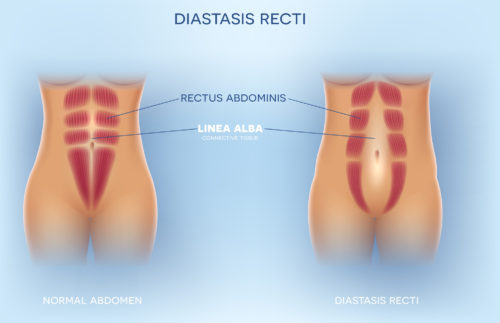What is diastasic recti?
What are the risk factors?
Multiple pregnancies
Large baby
Greater weight gain
Cesarean
What causes diastasis recti?
2. Pelvic Floor Dysfunction – This goes hand in hand with breathing. If our pelvic floor does not allow downward expansion, the pressure has no where else to go but forward, into the linea alba. Watch the entire video above.
(A pelvic floor that does not expand enough can cause other issues too such as a vagina that is too tight or pain with sex).
3. Muscular Imbalance – We have the rectus abdominus (RA), which is our six-pack abs, and the transverse abdominus (TA), which is our corset abs. If our six-pack is more dominant, there will be an imbalance with how the two muscles interact with each other, worsening the diastasis. The transverse abdominus is what stabilizes our spine! That’s why it is so important to strengthen our transverse abdominus. Fast forward the video below to 1:04 to learn how strengthen your natural corset.
4. Poor Posture – It’s no secret a lot of us have poor posture. A common one is called the sway back posture (first image), where the hips are pushed forward and the upper back is swayed backwards. This puts a stretch on the lower abdomen, stretching out the linea alba even further. Lordosis (second image) is when you create an excessive arch in your lower back. This posture puts a lot of pressure in your lower back and increased stretch in your abdomen. Our core is the happiest and is the most efficient when it is in neutral spine (third image), meaning your ribs are stacked over your pelvis.

Check out our post on correcting your posture, especially while sitting.
What else should I avoid?
1. Abdominal coning with lifting, exercise, and other daily activities – this is when the center of your abs pop up due to poor abdominal pressure management, as well as an underdominant transverse abdominus muscle. Again, this is why proper breathing technique and strengthening your natural corset is important. Watch the videos above if you haven’t done so already.
2. Avoiding excessive flexion such as crunches, is actually a myth! If you have good pressure mechanics and can activate the TA muscle first to avoid coning, crunches are a great way to strength the RA. This helps generate tension at the linea alba to provide stability in the spine and pelvis. Same thing can be said for planks. With that being said, if you have coning or have difficulty with pressure management, crunches and planks may not be for you at this time. It’s all about the QUALITY of the movement.
3. Constipation! Excessive straining causes increased intra-abdominal pressure, and that pressure will go forward into that linea alba making the diastasis worse. Make sure you’re not holding your breath when you push while on the toilet, but rather exhale slowly. Click here to learn how to fix your constipation for good!
4. Valsalva and breath holding should be avoided with functional movements and exercise. Always BREATHE!
How do I check for diastasis recti?
Your assessment will be made in 3 places – at the umbilicus, 4.5 cm above the umbilicus, and 4.5 cm below the umbilicus.
Start by lying on your back with your knees bent up. Place 2 fingers on your abdomen at the umbilicus. Then, raise your head and see if you can feel the edges of your six-pack. Repeat this step 4.5 cm above and below the umbilicus.
Positive test (+) More than 2 fingers sink into the space between your six-pack
Remember, 2 finger widths or smaller is considered normal.
Watch the video to see how it is done.


I had a total different idea about how this comes about but now am enlightened.
We are so glad to hear that! 🙂